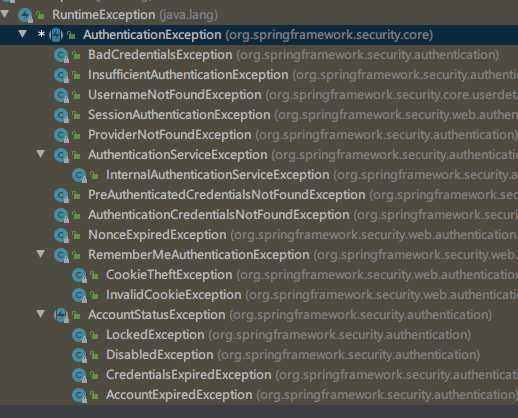标签:XML uil war ring string 分离 etc 账户 启动
添加依赖
<dependency>
<groupId>org.springframework.boot</groupId>
<artifactId>spring-boot-starter-security</artifactId>
</dependency>
不做配置时,每次访问都需要验证,用户名默认为user,密码为启动时控制台打印的密文(每次启动都会随机生成),访问/logout即可注销登录
手动配置(数据是写死的)
在spring5以后,security是不允许明文的,必须加密
在application.properties中配置
spring.security.user.name=user
spring.security.user.password=123
spring.security.user.roles=admin
在类中配置(注意继承了WebSecurityConfigurerAdapter,加上Configuration注解)
@Configuration
public class SecurityConfig extends WebSecurityConfigurerAdapter {
@Bean
PasswordEncoder passwordEncoder(){
//这个已过期,作用是无需加密,允许明文
return NoOpPasswordEncoder.getInstance();
}
@Override
protected void configure(AuthenticationManagerBuilder auth) throws Exception {
auth.inMemoryAuthentication()
.withUser("user").password("123").roles("admin")
.and() //可重复添加
.withUser("user1").password("123").roles("super");
}
}
HttpSecurity(登陆注销相关的配置,有点长,请耐心观看)
@Override
protected void configure(HttpSecurity http) throws Exception {
http.authorizeRequests() //开启登录配置
.antMatchers("admin/**").hasRole("admin") // 访问/admin下需要admin角色
.antMatchers("user/**").hasAnyRole("admin","user") //访问/user下需要admin或user其中一个角色
.anyRequest().authenticated() //除以上2个url 访问其他只需要登录
.and()
.formLogin()
.loginProcessingUrl("/login") //配置登录接口
.usernameParameter("uname") //定义用户名的key
.passwordParameter("passwd") //定义密码的key
//.successForwardUrl("xxxxx") 定义登录成功后跳转的页面(前后端不分离)
.successHandler(new AuthenticationSuccessHandler() {
@Override //定义成功后返回json数据 ,前后端分离
public void onAuthenticationSuccess(HttpServletRequest request, HttpServletResponse response, Authentication authentication) throws IOException, ServletException {
response.setContentType("application/json;charset=utf-8");
PrintWriter writer = response.getWriter();
Map<String,Object> map = new HashMap<>();
map.put("status",200);
map.put("msg","success");
writer.write(new ObjectMapper().writeValueAsString(map)); //将map以json格式输出
writer.flush();
writer.close();
}
})
.failureHandler(new AuthenticationFailureHandler() {
@Override //定义失败后的操作(前后端分离)
public void onAuthenticationFailure(HttpServletRequest request, HttpServletResponse response, AuthenticationException e) throws IOException, ServletException {
response.setContentType("application/json;charset=utf-8");
PrintWriter writer = response.getWriter();
Map<String,Object> map = new HashMap<>();
map.put("status",401);
if (e instanceof LockedException){
map.put("msg","账户被锁定,登陆失败");
}//在lockerException的父类的父类中就有很多异常,如下图,灵活使用
writer.write(new ObjectMapper().writeValueAsString(map)); //将map以json格式输出
writer.flush();
writer.close();
}
})
.permitAll() //登录接口对所有人开放
.and()
.logout()
.logoutUrl("/logout")
.logoutSuccessHandler(new LogoutSuccessHandler() {
@Override //注销登录
public void onLogoutSuccess(HttpServletRequest request, HttpServletResponse response, Authentication authentication) throws IOException, ServletException {
response.setContentType("application/json;charset=utf-8");
PrintWriter writer = response.getWriter();
Map<String,Object> map = new HashMap<>();
map.put("status",200);
map.put("msg","注销成功");
writer.write(new ObjectMapper().writeValueAsString(map)); //将map以json格式输出
writer.flush();
writer.close();
}
})
.permitAll();
}

多个HttpSecurity配置(使代码看起来更简洁)
@Configuration
public class Config2 {
@Bean
PasswordEncoder passwordEncoder(){
return NoOpPasswordEncoder.getInstance();
}
@Autowired
protected void configure(AuthenticationManagerBuilder auth) throws Exception {
auth.inMemoryAuthentication()
.withUser("user").password("123").roles("admin")
.and()
.withUser("user1").password("123").roles("super");
}
@Configuration
@Order(1) //优先级 ,数字越小,级别越高
public static class AdminSecurityConfig extends WebSecurityConfigurerAdapter(){
//参考SecurityConfig的配置
}
@Configuration
public static class UserSecurityConfig extends WebSecurityConfigurerAdapter(){
//参考SecurityConfig的配置
}
}
密码加密
@Bean
PasswordEncoder passwordEncoder(){
return new BCryptPasswordEncoder();
}
SpringSecurity使用的密码加密比MD5+盐更加严谨,即使相同的明文,加密的密文也一样,不易被暴力破解,而且不用解决存盐问题,当然,世界上没有绝对的安全加密,只能说更加安全。
? 如果有对你帮助,求点个赞。
标签:XML uil war ring string 分离 etc 账户 启动
原文地址:https://www.cnblogs.com/codezzz/p/12989053.html